Fuel Consumption for Various Dishes for a Wood-Fueled and Charcoal Fueled Improved Stoves used in Rural Northern Ghana
Ali Moro1*, Bernard Fei Baffoe2, Maxwell Dalaba3 and Abraham Oduro1
1 Navrongo Health Research Centre, Ghana
2Kwame Nkrumah University of Science and Technology, Ghana
3The University of Health and Allied Sciences-Ho, Ghana
Submission: March 30, 2020; Published: June 25, 2020
*Corresponding author: Ali Moro, Navrongo Health Research Center, Navrongo-Ghana
How to cite this article: Ali M, Bernard F B, Maxwell D, Abraham O. Fuel Consumption for Various Dishes for a Wood-Fueled and Charcoal Fueled Improved Stoves used in Rural Northern Ghana. Int J Environ Sci Nat Res. 2020; 25(1): 556156. DOI: 10.19080/IJESNR.2020.25.556156
Abstract
Up to 2.4 billion people (approximately 40% of the earth’s population) still depend on biomass as their main source of energy and currently, there are a wide variety of stove technologies and designs aimed at providing better cooking experience to end-users. The study design was cross-sectional, and data was collected between November to March of 2019 in the Kasena Nankana Districts. The study conducted 20 in-field uncontrolled cooking tests designed to assess the fuel consumption performance of the Ace stove and the Jumbo stove. Specific Fuel Consumption (SFC), Per Capita Biomass Consumption (PcBC) and Fuel consumption rate were calculated across a variety of meal types using the two stoves. An independent T-test was employed to determine the mean differences. The results showed that the Jumbo stove averaged 1.43±0.23kg of fuel per a cooking event with a per capita annual consumption of 38.06-274.97kg while the Ace stove averaged 0.31±0.04kg per cooking event with a per capita consumption of 14.6-75.65kg. There was a statistically significant difference between the fuel consumption rate per kg of food prepared (p<0.001) between the Ace stove and the Jumbo stove (Figure 1).
Keywords: Biomass consumption; Ace stove, Jumbo stove; Demographic surveillance survey; Cookstoves; Economic incentives
Introduction
In 2015, the Navrongo health research center with its partners introduced 2 new stoves: The African Clean Energy (Ace) stove and the Greenway Jumbo as part of a study [refer to SD: plate 1 & 2]. Generally, the project aimed to understand the interaction between the following factors on the household’s decision to adopt improved cookstoves: economic incentives (“prices”), social learning (“peers”) and subjective beliefs (“perceptions”) in technology adoption dynamics. The project was in two arms namely the P3 bio which involved rural households and the P3 Gas in the urban areas and involves the use of LPG.
The P3 bio was implemented in 50 clusters within the two Kasena Nankana Districts (KNDs) [1-5].
This paper sort to understand the fuel consumption characteristics of the two stoves in an uncontrolled setting.
Material and Methods
The stove biomass consumption described herein was completed in the Kassena Nankana Municipal and the Kassena Nankana West District (KND’s) of the Upper East Region of Ghana (Figure 2).
Study area
The KNDs can be located on longitude 10o53’5” N and Latitude 1o5’25” W. The climate in the region is arid and hot with an annual rainfall of about 950mm. The vegetation in this area is dominated by woody shrubs and grassland with one rainy season lasting from approximately May to October. Much of the land is used for subsistence agriculture, with corn and millet as the dominant crops cultivated. The study area is within the catchment area of the Navrongo Health Research Center (NHRC) which has conducted a district-wide Health and Demographic Surveillance Survey (HDSS) and several other research studies since 1993 [6].
The KNDs population is organized into settlements known as compounds and comprises multiple households belonging to a single lineage living together and presided over by a compound head (mostly a male figure). Inside these organized settlements are households made up of a sub-divided group of people that usually eat from a common cooking source. According to the Navrongo Health and Demographic Surveillance System (NHDSS), the population of the 2 districts is about 156,000 with about 80% living in rural areas while 20% are in more urban areas such as the central town of Navrongo. About 88% of rural households rely mainly on firewood as their main cooking fuel, while another 9% rely primarily on charcoal and only about 3% of households cook primarily with gas or electricity. The traditional cooking method in these rural areas is a three-stone open fire, with many households also using charcoal stoves [6].
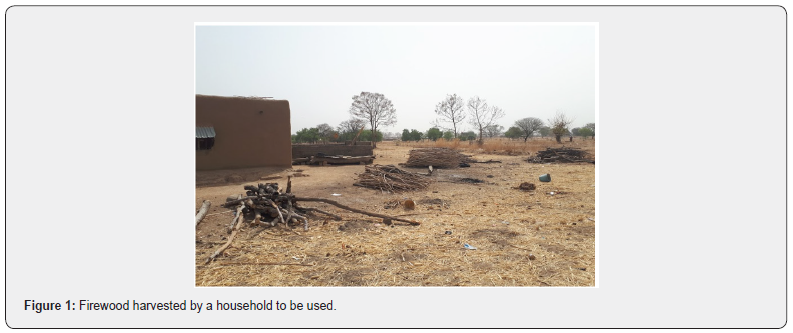
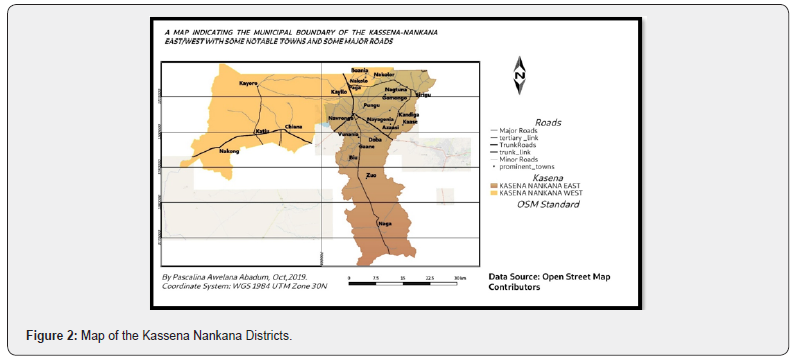
Study design
The study design was cross-sectional. The Uncontrolled Cooking Test (UCT) method was also adopted for this study to gain a better understanding of the performance of the stoves and the cooking system over a wider range of variables. This method of cookstove test has been developed by the University of Johannesburg SeTAR center. In this method, the meal is not constrained, therefore the Cook is free to prepare what they want, how they want it, where they want and when they want. the UCT allows the cook to prepare a local dish of their size and type using local fuels. The cook’s preferences inherently add to the test variability.
Sampling procedure
The sampling technique employed in this study was the multi-stage sampling method. Ten (10) clusters out of the 50 P3 clusters were randomly sampled (2 each from the 5 NHDSS zones). Twenty (20) households within the 10 sampled clusters were again conveniently sampled.
Cooking systems
In-field stove performance testing was conducted on the two types of stoves (The Ace stove and the Jumbo stove).
Greenway Jumbo Stove
This is a single burner, high-efficiency, portable, metallic and non-chimney cookstove (Plate 1). It is designed to suit large families and small cafeterias. This stove can use any type of solid biomass fuel such as cow dung, wood, and agricultural waste. It uses less fuel than traditional mud cookstoves and produces less smoke. It reduces the time and/or money users spend buying fuel or collecting and allowing for a more comfortable cooking experience (Figure 3).
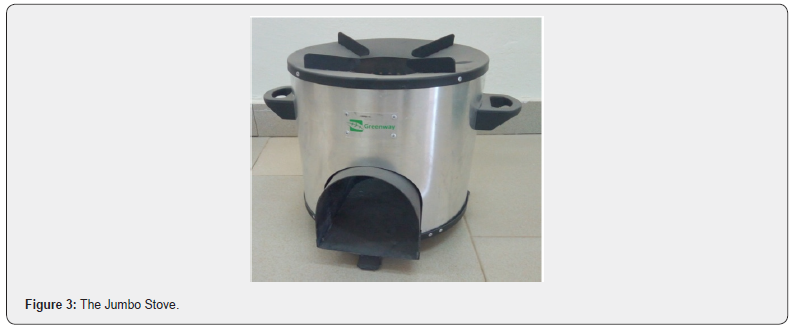
Features of the Jumbo stove
a) Size: 12.4” x 10.6” x 11.6”.
b) Materials: Steel and Aluminum with Bakelite Handles.
c) Loading Capacity: 40kg.
d) Secondary Air Induction Mechanism: Yes.
e) Fuel Savings: 65%.
f) Smoke Reduction: 70%.
g) Ergonomic front-loading design.
ACE 1 Cook Stove
The ACE 1 Solar Biomass cookstove is a multifunctional tool, combining a smoke-free cooking experience with LED lighting and access to energy for mobile devices (Plate 2). The stove comes in different colors and burns a variety of biomass fuels cleanly. The stove saves around 70% of fuel compared to traditional stoves (Figure 4).
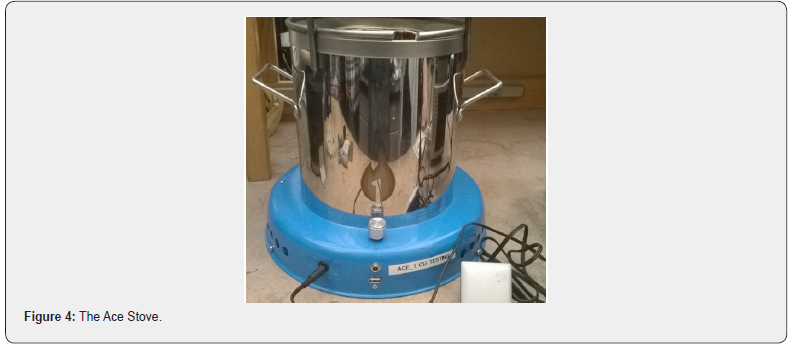
Features of the Ace 1 stove
a) Height: 32cm.
b) Diameter (at top of stove): 22.5cm.
c) Weight: 4.6kg.
d) Fuel Chamber Volume: 842cm3.
e) Firepower: Max 4,000 – 5,000 watts, Min 2,000 – 3,000 watts.
f) Stove Body: Stainless Steel (grade 430).
g) Stove Base: Powder Coated Galvanized Steel.
h) Pot Rest: Galvanized Steel.
(Figure 5) The Three-stone-stove using wood and agricultural waste is the primary stove in the study area with others using coalpot as a secondary stove [7]. Cooking fuel in the KND’s is mostly firewood (plate 1) and charcoal sourced mostly from Vitellaria Paradoxa and shrub-branches. Although both stoves can burn all types of biomass (wood products and agricultural residues), charcoal and firewood were used by participants in this study for the Ace stove and the firewood respectively. A variety of means are prepared in the study area, but the common meal is rice and Tuo Zaafi (TZ). Meals are prepared in cast aluminum pots of different sizes depending on the size of the family.
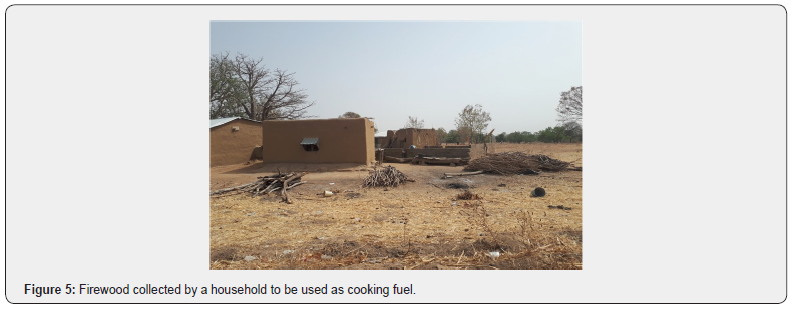
Performance metrics and fuel measurements
A date was scheduled with the primary cook for the cooking event to be observed. The participant (primary cook) was given enough time to prepare for the day of the measurement. The participant then decides the time of day the meal is to be prepared (Breakfast, Lunch or Supper).
Before the test on the given day, any existing fire was extinguished, and the cooking area was cleared of char and wood. The sufficient wood needed for the meal was separated from the rest of the fuel. This is placed in a pile next to the fire. This was the fuel to be used for the duration of the observation. The pile was then weighed on the digital scale. Fireplace/stove type, cooking area, and ambient conditions (windy, rainy, etc) were noted.
The participant was then asked to make a fire as they normally would, with the method and start time noted and lighting materials weighed. The participant was left to prepare the meal. The timings and food types were noted. When the participant signaled the end of the meal preparation, the time was recorded. The fire was then put out and any burning wood was extinguished by a moist cloth. The remaining fuel was then weighed (no ash). Any burnt wood was also weighed. Any remaining unburned wood in the pile was also weighed. A questionnaire was then administered to further explain the behaviors of the cook and household characteristics (Table 1).

Fuel Consumption Rate (FCR), Per capita Biomass Consumption (PcBC) and Specific Fuel Consumption (SFC) was calculated using:

Ethical approval
The study protocol was reviewed and approved by the Institutional Review Board of the Navrongo Health Research Centre. Oral Informed consent was obtained from all study participants before any data collection.
Results and Discussion
Twenty (20) UCT’s (Ace: n = 12 and Jumbo: n= 8) were completed between November 2018 and March 2019 [see SD table 2]. The data was normally distributed therefore allowing for the use of means and standard deviation to statistically calculate for the difference in consumption. Statistical significance was assessed at a 5% significance level.
Characteristics of the primary cook and the household
The social characteristics of the primary cook and the household can be seen in table 2. Most of the primary cooks (30%) were between the ages of 36-41 years with all being females. The culture of the people of Northern Ghana frowns on the male gender to be engaged in domestic chores which are seen to be reserved to the female gender. 75% were Christians, 15% Muslims, 5% Traditionalists 5% had no religious affiliation. This conforms to the national data where 71.2% of the population are Christians with 17.6% and 5.2% being Muslims and traditional religion respectively [8]. Economically, 45% were self-employed (petty trading (35%) or in small scale industry (10%)). About 35% of the remaining participants stated they were farmers with 10% stating they were students. 5% did not engage in any economic activity and 5% also said they were engaged in casual labor.
45% of the primary cooks had no formal education which is about the same as estimated by the Ghana Statistical Service (44.5%) [8]. 40% had basic education with only 5% and 10% attaining secondary education and College education respectively. 65% of them were married, 10% were single while 20% and 5% were widowed and divorced respectively. Altogether, 35% of them were single that is, they have never been married, or have lost their husbands, or divorced. Most of the participants who cook were married. This may be attributed to the fact that they have nuclear families and must cook for them.
In terms of the household size of the participants which is the same as the number of people the meal prepared was going to feed, 65% of them had a household size of 4-6 people while 35% represented households with 7 - 9 people (Figure 6).
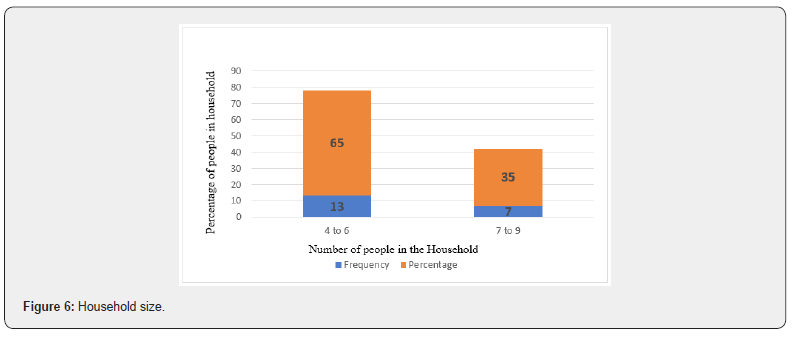
This correlated with the average household size of the area [8] and the relatively large household size implies a large quantity of food needed to be prepared which will mean more fuel and more degradation.
Household general stove ownership was also looked at with 55% of the households owning 4 stoves while 20%, 15% and 10% of the participants owned 5, 3 and 6 different stoves respectively (Figure 2 & 7).
Cooking observation and fuel type
11 different food types were prepared (Table 2 & 3). Jollof rice was prepared the most-5 times (thrice with an Ace and twice with a Jumbo stove). TZ was prepared 4 times; 2 each with an Ace and a Jumbo stove while Vegetable soup and Rice balls were both prepared twice but a Jumbo and an Ace each prepared the vegetable soup and both rice balls cooking activity being prepared on a Jumbo. Other meals prepared included; groundnut soup, “Kaponnu”- (this is a local meal which is prepared using cracked or broken millet or corn, it is prepared in porridge form), Plain rice, Spaghetti, stew, TZ, rice and beans and Tubani (a local meal prepared with beans).
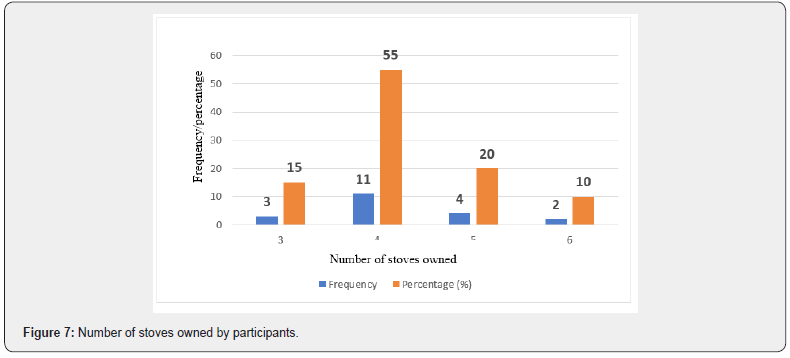

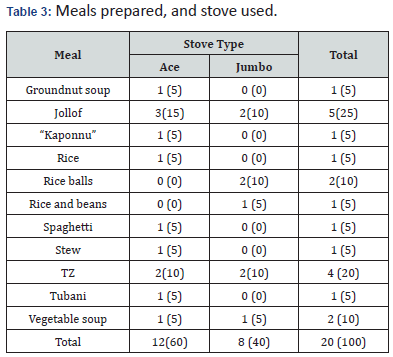
Although most of the households (n=12) used the Ace stove in this study, 55% stated firewood as their main source of fuel while 40% stating charcoal was the main source of fuel. The remaining 5% stated they used both fuels equally.
Fuel consumption Mass consumption
This study was conducted during the dry season (between November 2018 and March 2019) and the consumption rates and patterns reported here apply mainly to that part of the year. This is so because there may exist seasonal variations in fuel choices, sourcing patterns, demand, and availability (Figure 8-10).
For the 12 cooking observations that used charcoal (Ace stove), a total fuel mass (Charcoal) of 3.72kg with an average of 0.31kg ± 0.04 per cooking activity was consumed while that of the Jumbo stove was calculated at 11.46kg of wood that is an average of 1.43 ± 0.23kg of wood per cooking activity. Cumulatively, cooking fuel of mass 15.18kg was consumed for all 20 cooking observations; that is the difference of before fuel mass of 41.92kg and an after mass of 26.74kg (Figure 3 & 11).
Consumption rate
Fuel consumption rate which is calculated by fuel used against time (Eqn. 1), for the various meals prepared with the respective stoves (Table 4). the mean consumption rate for the Ace stove was recorded as 0.005±0.001kg/min meaning the Ace stove burnt 0.005kg of fuel every 1 minute whereas the mean consumption rate of the Jumbo stove was calculated as 0.019±0.002kg/min. There was a statistically significant difference (p<0.001) between the fuel consumption rate of the Ace stove and the Jumbo stove.
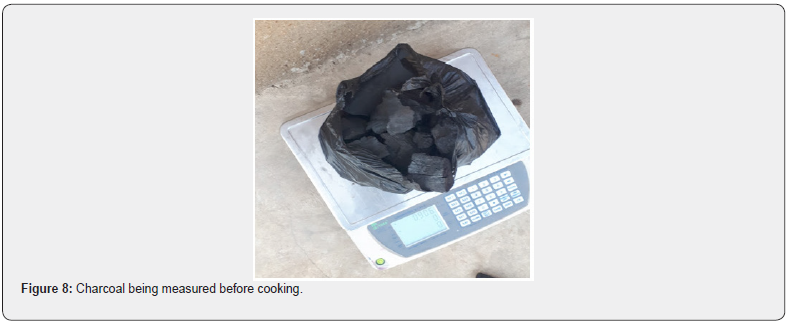
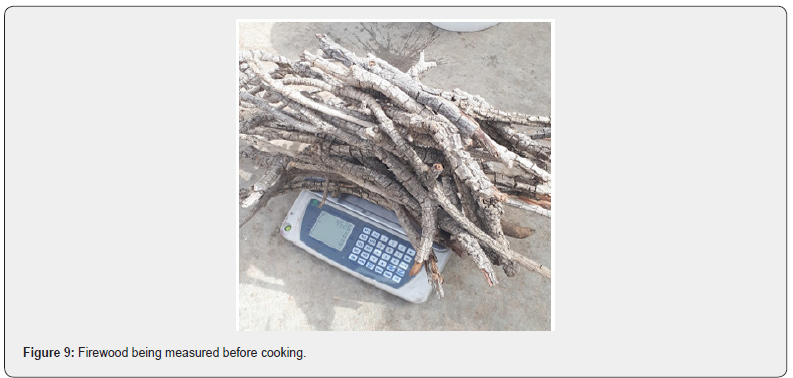
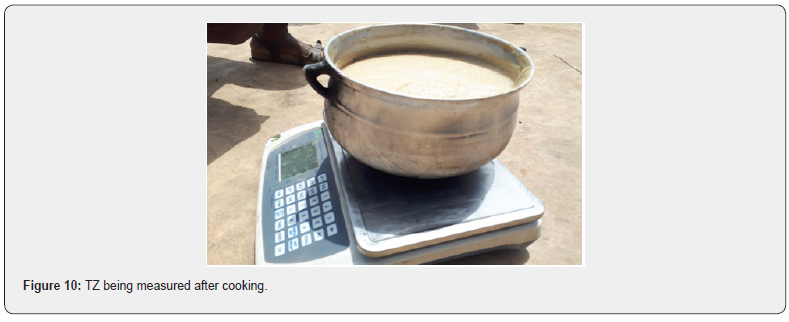
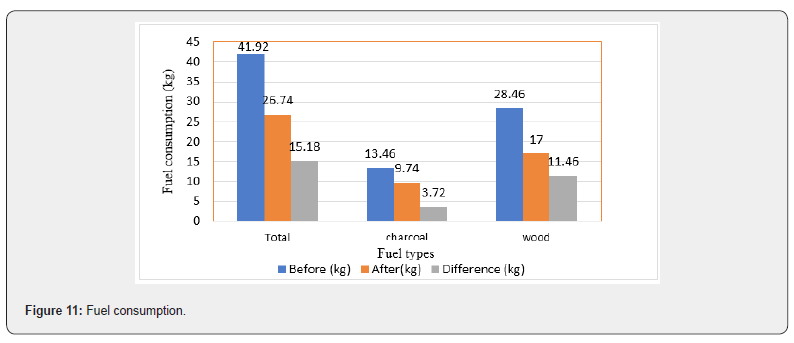
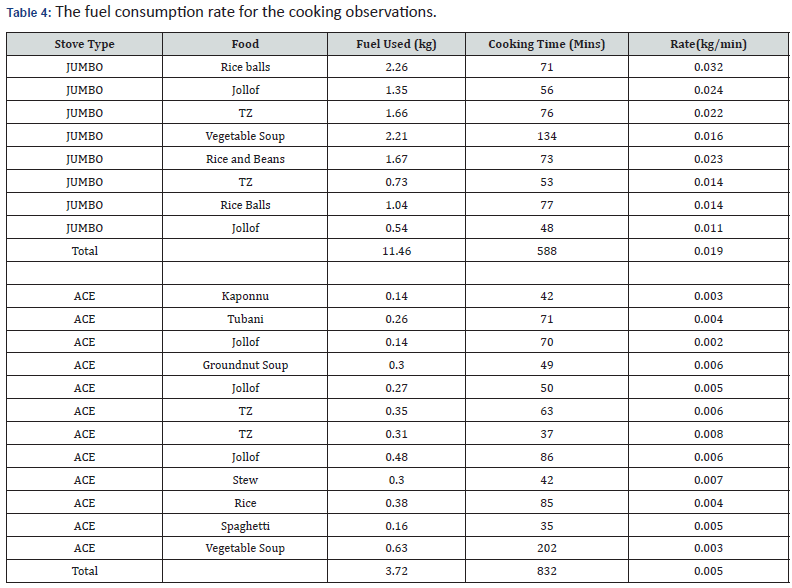
Per capita consumption
The dependence on wood and other non-commercial fuels in the rural areas of most developing countries is often the only cooking fuel source with animal dung and crop residues being the principal non-commercial fuels other than wood and charcoal. To understand the effects of these stoves or household fuel consumption on forest and plants, then, there was the need to calculate for the per capita biomass consumption (Eqn…2).
It was calculated that a person within a household that prepare one meal a day, will consume an average of 38.06kg of wood using the jumbo stove and 18.25kg of charcoal using the Ace stove per annum. However, a person from a household that prepared 2 meals a day was extimated to consume wood of mass 161.27kg annually based on measured consumption from cooking activity whereas a member of a similar household using the Ace stove was estimated to consume charcoal of mass 48.56kg per annum. Finally, a member of a household that prepared 3 meals a day was extimated to consume wood using the Jumbo stove of mass 230.66kg while that of the Ace stove was calculated at 44.10kg per annum. An average household using an Ace stove was therefore estimated to consume charcoal of mass 539.04kg per annum whereas that of the Jumbo was estimated to consume firewood of mass 1375.11kg per annum (Table 5).
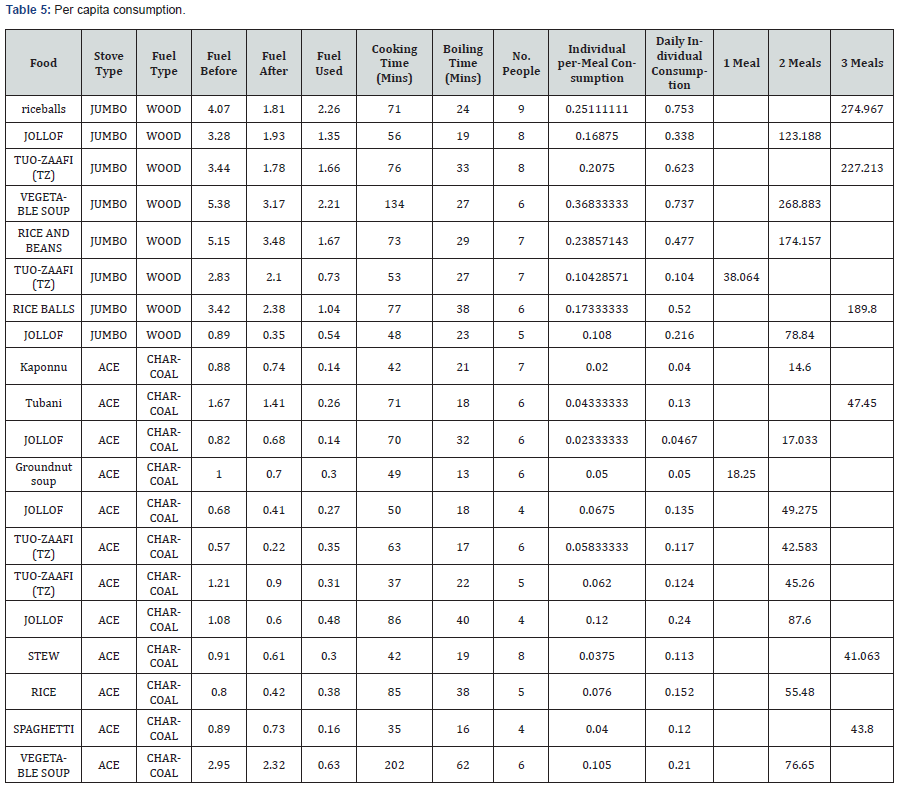
Specific fuel consumption
Specific Fuel Consumption (SFC) can be defined as the amount of solid fuel used comparably to achieve a defined task divided by the weight of the task. SFC indicates how efficiently a stove converts chemical energy into heat energy (eqn…3). The mean SFC was calculated at 0.186 while that of the Jumbo and the Ace are 0.272 and 0.129 respectively. Meaning the Jumbo stove will require 0.27kg of firewood to prepare a kilogram of food, while the Ace will only require 0.13kg of fuel to prepare the same kilogram of food (Table 6).
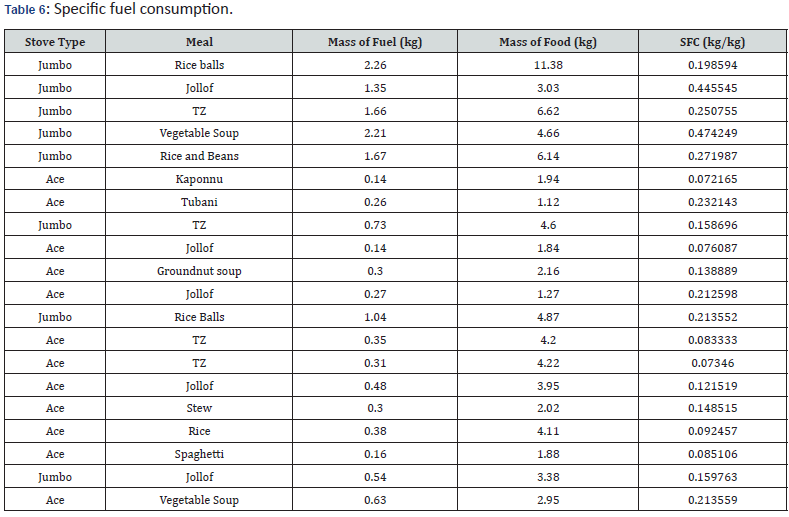
Discussion and Conclusion
The majority of the households owned at least four different stoves with no household stating they had less than three stoves. The practice of stove staking (cooking with more than 1 stove at a time) in the study area is very common as households rely on different stoves for different cooking activities at different seasons. For example, the three-stone stove is mostly used outdoors during the dry season and for preparing larger meals during occasions like funerals. In terms of stove ownership, most of the people owned an Ace stove followed by Jumbo stove with few people owning LPG which is higher in the energy rung as. This outcome was so because households in the study area were located in rural communities which are characterized by poverty hence their inability to purchase and continue to refill the cylinders and lack of access to gas refilling stations.
Juxtaposing observations that involved similar meals the following can be observed from the Table; 3 different food types were prepared using both stoves and these common foods are Jollof, TZ and vegetable soup. With Jollof, it was prepared 2 times using the Jumbo stove and had a fuel consumption rate of 0.024kg/ min and 0.011kg/min, while it was prepared 3 times using the Ace and recording a fuel consumption rate of 0.002kg/min, 0.005kg/ min and 0.005kg/min. The vegetable soup which was prepared using both stoves once also had a consumption rate of 0.016kg/ min and 0.003kg/min for the Jumbo and Ace respectively. TZ also recorded a consumption rate of 0.022kg/min and 0.014kg/min for the jumbo stove as against 0.005kg/min and 0.008 kg/min as recorded by the Ace stove.
The Ace stove was seen to have consumed about 175kg of charcoal more than the average Upper East Region’s household annual consumption of 364kg [9] while that of the Jumbo stove was also estimated to be higher than the regional firewood consumption of 1037 [9]. The two stoves, however, had a superior Per capita consumption as compared to traditional stoves that use similar fuels in neighboring districts in the region [10]. Comparing the SFC with an earlier study done in the arear, Ace stove has the best SFC thus uses less fuel to prepare food. It is followed by Philips with wood which has an SFC of 0.19. The Jumbo stove is only superior to the coal pot and the 3 stone stove which have 0.28 and 0.3 respectively [11]. This implies that switching to the Ace stove or the Jumbo stove will put more stress on the environment than already is as more trees will be needed to produce fuel. And as more trees are being cut, deforestation will occur which will result in the exposure of the soil to erosion and unavailability of trees to act as carbon sinks for toxic emissions. The superior consumption rate of the Ace stove is what accounts for the less mass of fuel that is consumed during the study and this can also be seen in the annual per capita consumption rates as the Ace stove will consume less fuel as compared to the Jumbo stove.
The burning of biomass as fuel has been known as one of the most significant causes of forest deterioration in many developing countries [12]. The rapid loss in forest cover appears to have consequences for the climate system such as drought, flooding, Change in land use, biodiversity and soil fertility loss and land degradation and lowering of water levels in the study area and Ghana as a whole [13,14]
Acknowledgement
Special thanks to all the participating households in this study for welcoming us into their home. We also acknowledge the Navrongo Health Research Center and all the staff especially Desmond Agao, Shahud Ibn I Azimlogo, Edwin Wangara and Nobert for helping in data collections.
Availability of Data
The data that support the findings of this study are available from the corresponding author upon reasonable request.
References
- Oduro AR, Wak G, Azongo D, Debpuur C, Wontuo P, et al. (2012) Profile of the Navrongo health and demographic surveillance system. International Journal of Epidemiology 41(4): 968-976.
- KL Dickinson, E Kanyomse, R Piedrahita, E Coffey, IJ Rivera, et al. (2015) Research on Emissions, Air quality, Climate, and Cooking Technologies in Northern Ghana (REACCTING): study rationale and protocol. BMC Public 126(2015).
- Ghana Statistical Service (2013) 2010 population census-Kasena Nankana Municipality. GSS, Accra.
- Energy Commission of Ghana (2017) National Energy Statistics. Strategic planning and policy directorate, Accra.
- Amoah M, Marfo O, Ohene M (2015) Firewood consumption pattern, availability and coping strategies adopted to mitigate firewood scarcity: a case of rural households in Ghana. Forests, Trees and Livelihoods 24(3): 202-218.
- Coffey ER, Muvandime D, Hagar Y, Wiedinmyer C, Kanyomse E, et al. (2019) New Emission Factors and Efficiencies from in-Field Measurements of Traditional and Improved Cookstoves and Their Potential Implications. Environmental science and technology 51(21): 12508-12517.
- Chengappa C, Edwards R, Bajpai R, Shields KN, Smith KR (2007) Impact of improved cookstoves on indoor air quality in the Bundelkhand region in India. Energy for Sustainable Development 11(2): 33-44.
- Daioglou V, Ruijven BJV, Vuuren DPV (2012) Model projections for household energy use in developing countries. Energy 37(1): 601-615.
- World Energy Assessment (2004) WEA Overview: 2004 Update. Part III Energy and Major Global Issues. Energy and Major Global Issues, New York, USA.
- Energy Commission, Ghana (2006) Strategic National Energy Plan 2006 – 2020. Energy Commission, Ghana, Accra.
- Abavana (2000) Ghana: Renewable Energy for Rural Electrification. In Village Power 2000 Conference. Empowering People and Transforming Markets, Washington DC, USA.
- Global Forest watch.
- Smith KR, McCracken JP, Thompson L, Edwards R, Shields KN, et al. (2009) Personal child and mother carbon monoxide exposures and kitchen levels: methods and results from a randomized trial of woodfired chimney cookstoves in Guatemala (RESPIRE). Expo Sci Environ Epidemiol J Expo Sci Environ Epidemiol 20(5): 406-416.
- Bryden KM, Johnson NG (2012) Factors affecting fuelwood consumption in household cookstoves in an isolated rural West African village. Energy 46(1): 310-321.






























